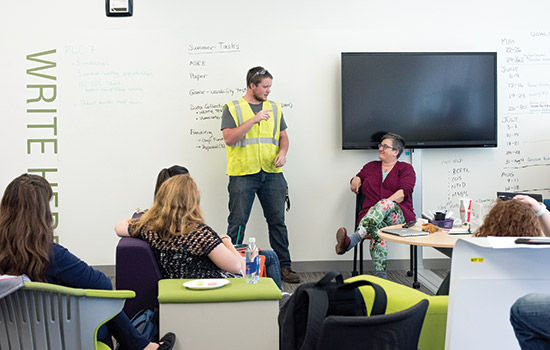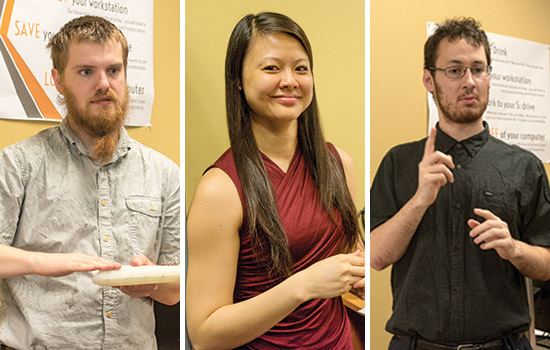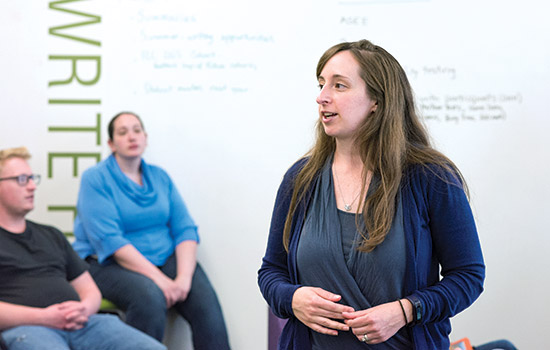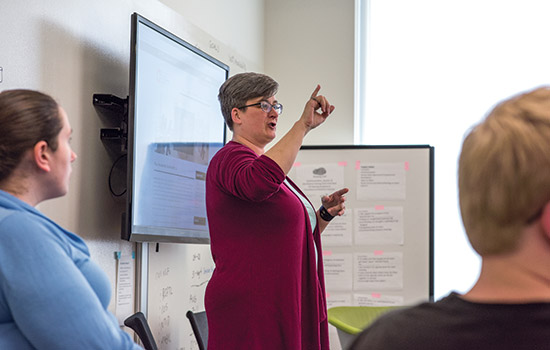Finding ways to enhance learning for deaf students
Making Connections: Sara Schley, director of NTID's Research Center for Teaching and Learning, is using a National Science Foundation grant to connect hearing and deaf communities with the goal of improving STEM learning.
National Technical Institute for the Deaf researchers are working to improve education and provide more support for deaf and hard-of-hearing students.
National Science Foundation Grant
As a deaf student majoring in psychology, Joshua Mora looks for ways to enhance his learning in scientific environments that are traditionally comprised of hearing peers and faculty.
In order to fulfill his and other students’ needs for diverse methods of information dissemination and a greater understanding of learning styles within the deaf and hard-of-hearing community, a new project has been launched—one that uniquely connects hearing and deaf communities and will result in effective STEM learning for deaf and hard-of-hearing students.
Since this past spring, the National Technical Institute for the Deaf’s Faculty Learning Communities program has been developing training and “accessibility toolkits” for faculty in STEM disciplines who are searching for viable ways to adapt their teaching methodologies to accommodate the learning needs of their deaf and hard-of-hearing students. The communities—facilitated by hearing and deaf faculty pairs in similar disciplines—brainstorm alternative learning ideas, propose experiments, and test the efficacy of the alternatives.
Sara Schley, director of NTID’s Research Center for Teaching and Learning and principal investigator, said the project, which was funded through a three-year, $443,200 grant from the National Science Foundation, combines faculty engagement in instructional change, universal design for teaching and learning, and student-centered pedagogy that all ultimately enhance inclusiveness within the classroom. Co-principal investigator on the grant is Stephanie Cawthon from The University of Texas at Austin.
“Faculty members who teach deaf and hard-of-hearing students may assume that notetaking services and interpreting services, for example, are tools that sufficiently provide an adequate learning environment,” Schley said. “While these services certainly assist the students with their learning, we’ve found that there are many other ways that instructors can adapt their teaching styles to enhance the learning environment for our students. This project is meant to provide relevant information to our faculty in a supportive way.”
One Scenario
Schley cites one example. Inside the classroom, faculty may explain complicated STEM concepts by showing slides while sign-language interpreters translate the information to a deaf student. However, it’s extremely difficult for deaf and hard-of-hearing students to look at slides while watching an interpreter. This often results in the student missing valuable dialogue and classroom interaction.
In the scenario mentioned above, added Schley, faculty may experiment with pausing after showing a slide or writing on a white board and checking for “eyeballs” in order to be sure that students have finished reading the information and are ready to shift their focus back to the instructor or the interpreter.
Students like Mora, a fourth-year student from Fremont, Calif., who view this project as an opportunity for them to thrive in RIT’s rigorous educational setting, are serving in mentorship roles—valuable resources for hearing faculty who are encouraged to seek feedback and perform “dry runs” on potential strategies. Mora also believes the project offers a forum where an exchange of ideas will increase student engagement.
“If a teacher has concerns about how to make curricula accessible, we are available to provide guidance,” he said. “This project has a direct impact on student engagement and motivation in the classroom, and I think it will ultimately encourage more deaf and hard-of-hearing students to enter STEM fields with confidence.”
Schley sees a steady progression in the advancement of the initiative. RIT’s Teaching and Learning Services, a unit of the Innovative Learning Institute, is developing a “toolkit” website that can be readily accessed by faculty looking to expand their instructional methodologies. And as the project develops over the next few years, Schley said that the learning communities will be asked to investigate applications using more advanced technology such as “flipped” learning. In this case, faculty might add cues for students that encourage them to pause and review a graphic explanation after seeing a captioned explanation.
Individualized Instruction
Robert Garrick, a manufacturing and mechanical engineering technology professor in RIT’s College of Applied Science and Technology, teaches future engineers using a technology-rich, interactive learning environment with hundreds of instructor and student videos in a classroom with 10 interactive projectors.
“I am especially interested in this project to understand how we, as instructors, can improve accessibility with the emerging multimedia tools we use,” said Garrick. “Our teaching and accessibility techniques are hopefully evolving as quickly as our technology tools in order to provide individualized instruction while giving continuous feedback to each student based on their needs.”
Jennifer O’Neil, assistant professor of mechanical engineering technology, joined the RIT faculty in 2016. While she has always focused on building course work around different teaching pedagogies that promote improved student learning and engagement, she felt that her participation in this project would sharpen her skills working with a diverse and unique student population—RIT’s deaf and hard-of-hearing students.
“I am continuously striving to improve my teaching effectiveness,” said O’Neil. “Before I was faced with any challenges in the classroom, I decided to join the learning community to learn alternative strategies to improve student engagement and retention, but more importantly to make meaningful changes in the classroom that would enhance the learning experience for all students.”
Schley added that, simply put, the project is about the best way to engage in collaborative learning because there are many different kinds of learners in the same classroom.
“We’re helping our faculty to take a little more time to think about meeting the needs of their students and designing activities that don’t depend on a particular channel of information. This is about good teaching.”
On the Web
 Sara Schley, principal investigator of the Faculty Learning Communities project, leads a session of faculty and students who are gathered to brainstorm strategies that promote inclusivity for deaf and hard-of-hearing students in STEM disciplines. RIT/NTID student AJ Passarelli, a student research assistant working with faculty mentors, offers suggestions to the group.
Sara Schley, principal investigator of the Faculty Learning Communities project, leads a session of faculty and students who are gathered to brainstorm strategies that promote inclusivity for deaf and hard-of-hearing students in STEM disciplines. RIT/NTID student AJ Passarelli, a student research assistant working with faculty mentors, offers suggestions to the group.
 Active Learning: From left to right: RIT/NTID students Kyle Blakely, Jessica Luu, and Brian Johnson-Pasqua implemented new presentation methods in Assistant Professor Jennifer O'Neil's class that encouraged student learning and engagement among deaf, hard-of-hearing, and hearing students.
Active Learning: From left to right: RIT/NTID students Kyle Blakely, Jessica Luu, and Brian Johnson-Pasqua implemented new presentation methods in Assistant Professor Jennifer O'Neil's class that encouraged student learning and engagement among deaf, hard-of-hearing, and hearing students.
 Jennifer O'Neil, assistant professor of mechanical engineering technology, participated in the Faculty Learning Communities project this past spring semester. Here, O'Neil implemented a new presentation method in her class that facilitated engagement between her deaf and hard-of-hearing students and hearing students.
Jennifer O'Neil, assistant professor of mechanical engineering technology, participated in the Faculty Learning Communities project this past spring semester. Here, O'Neil implemented a new presentation method in her class that facilitated engagement between her deaf and hard-of-hearing students and hearing students.














